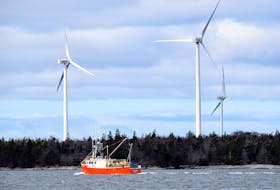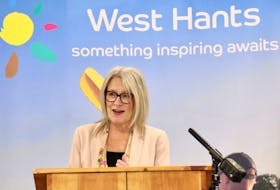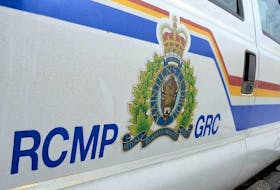
The release of the long-awaited study was good news for MacDonald, hearing that the section of the Trans Canada Highway where he and his emergency crew often respond to collisions – 15 of which in the past seven years have been fatal – is considered feasible.
The Barneys River Fire Department chief has long been an advocate for twinning Highway 104 between Sutherlands River and Antigonish, and he wants to see it done sooner rather than later – even if that means tolls.
“It’s very refreshing to see that they’re moving ahead with the next step and it’s very feasible for people and it’s very reasonable tolls – between six and 10 cents (per kilometre),” he said in a phone interview after attending a government briefing on the study conducted by CBCL Limited and released by the provincial government in Halifax on Thursday afternoon.
Highway 104 between Sutherlands River and Antigonish is considered a good candidate for twinning, according to an assessment done as part of the study.
It looked at a number of objectives and priorities in order to rank the eight sections of highway studied.
The criteria included traffic volumes, financial viability, travel time and cost savings, collision reduction, environmental issues and land acquisition.
The local section of highway was ranked number three out of eight and was considered to be of reasonable financial viability.
The study used toll amounts of six to 10 cents per kilometre – which aligns with existing Cobequid Pass toll rates – and is based on results of a willingness-to-pay survey conducted by CBCL.
A government release said the rates do not necessarily reflect what a toll rate would be, should Nova Scotians decide to proceed with tolling.
Transportation and Infrastructure Renewal Minister Geoff MacLellan has stressed that the province is neutral on the results of the study.
“We just want to do what Nova Scotians think is right,” he said Thursday during the briefing.
Now the first phase of the study is complete, MacLellan said the next step is to gather feedback from the public. The public meetings haven’t yet been scheduled, but he said the government is committed to gathering public response.
He added that it’s not the government’s intention to “shelf” the report. The second phase of the study will include more detailed cost estimates and public input.
The government has made it clear that highway twinning by using tolls will not go forward without the public’s approval. As far as whether Nova Scotians will support tolls, MacDonald has more than 8,000 names of people on an online petition who want to see the highway twinned as soon as possible.
“I think people realize Nova Scotia is not a rich province right now,” he said, adding that, without tolls, the highway won’t be twinned anytime soon and that he thinks people will pay to ensure the safety of their families.
The study estimated collisions on Highway 104 between Sutherland’s River and Antigonish would be reduced by nearly 30 per cent. CBCL studied collision types in each section of highway to determine the number that could be reduced by twinning.
In that same section of highway, there were an average of 39.2 collisions per year – based on data between 2010 and 2014 – which could potentially be reduced by 11.6.
MacDonald acknowledged that a twinned highway would likely still see collisions, but believes there would be a significant drop in fatalities.
The full report can be viewed at www.novascotia.ca/twinning.
On Twitter: @NGNewsAmanda
By the numbers
Untwinned highway: 37.8 kilometres
Estimated construction cost: $257.9 million
Estimated operation, maintenance & rehabilitation cost: $3.8 million/year
Twinning Highway 104 between Sutherland’s River and Antigonish would reduce collisions yearly by nearly 30 per cent.
This figure is according to an estimate from an independent study on the feasibility of using tolls to pay for Nova Scotian highway twinning.
On Thursday, the provincial government released the study, conducted by Halifax-based engineering firm CBCL Limited, regarding twinning eight sections of highways.
The report ranks the feasibility of the eight sections based on the analysis of the following criteria:
• safety and the number of collisions
• cost versus projected revenue
• average traffic per day
• travel time and travel cost savings
• environmental concerns
• land acquisition
The estimated collision reduction is based on the average collisions per year between 2010 and 2014 and the elimination of intersection-related, angle and head-on collisions as well as some reduction in single-vehicle, rear-end and sideswipe collisions.
On Highway 104 between Sutherland’s River and Antigonish, there were an average of 39.2 collisions per year, which could potentially be reduced by 11.6.
Government invests roughly $420 million each year to build and maintain roads in Nova Scotia. It would cost more than $2 billion to build the road infrastructure Nova Scotians have told government they want.
"Nova Scotians have told us they want better, safer highways, but twinned highways are very expensive," said Transportation and Infrastructure Renewal Minister Geoff MacLellan. "We committed to explore whether twinning could be feasible using an alternate funding method, such as tolling. We also committed to providing everyone with the same information so we could have an informed discussion."
The study used benchmark toll amounts of six to 10 cents per kilometre, based on results of a willingness-to-pay survey conducted by CBCL. The rates do not necessarily reflect what a toll rate would be, should Nova Scotians decide to proceed with tolling.
"I need to be very clear, government has not made a decision to move forward with twinning through tolling," said MacLellan. "We now have the data that will provide the foundation for a discussion with Nova Scotians."
The eight sections, a total of 301.2 kilometres, included in the study are:
• Highway 101, Three Mile Plains to Falmouth, 9.5 km
• Highway 101, Hortonville to Coldbrook, 24.7 km
• Highway 103, Exit 5 at Tantallon to Exit 12 Bridgewater, 71 km
• Highway 104, Sutherlands River to Antigonish, 37.8 km
• Highway 104, Taylors Road to Aulds Cove, 38.4 km
• Highway 104, Port Hastings to Port Hawkesbury, 6.75 km
• Highway 104, St. Peter's to Sydney 80 km
• Highway 107, Porters Lake to Duke Street, Bedford 33 km
This is phase one of the study. The next phase will refine cost estimates, package the financial data, and gather input from Nova Scotians. The government says it plans to consult widely with Nova Scotians about their views on tolling.
The full report is available at www.novascotia.ca/twinning.
More to come








